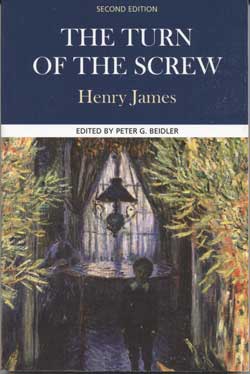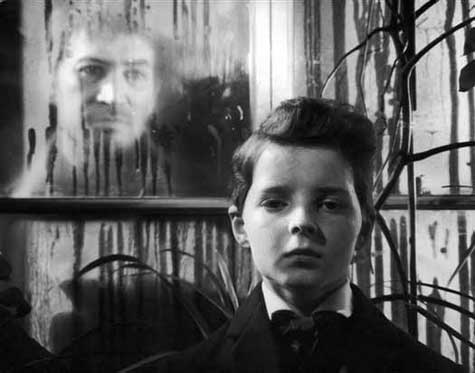 Disturbing specter or spectral delusion? Predatory phantom or primitive fear? Dead face at the window or live madness in the mind’s eye? It’s for you to decide…
Disturbing specter or spectral delusion? Predatory phantom or primitive fear? Dead face at the window or live madness in the mind’s eye? It’s for you to decide…
In 1898, as the Victorian era drifted towards its close, Henry James added to the world’s trove of ghost stories with a short novel that, to this day, has never lost its punch. James, scion of a New York banking family, had moved to England in the late 1860s and had already established himself as a top-shelf author by the time he wrote The Turn of the Screw. Penned in its author’s trademark ornate style, the novella’s plot is subtle and sinister. A young governess (whose name we never learn) is dispatched to a country house in Essex to give care and guidance to two young orphans. Though the boy has been tossed from his private school for some unspecified “wickedness,” both he and his sister seem to be gentle, pleasant children. Through the housekeeper, the governess learns of two former employees, both now dead, who seemed to have had an unhealthy grip on the children. In the course of the tale, the governess comes to believe that the ghosts of Peter Quint and Miss Jessel are attempting to claim her charges. She senses the presence of the unsavory pair, and, what’s more, she sees them.
And therein lies the question at the heart of the tale: do these wraiths really prowl the halls of the old estate? What is casting its ominous shadow over the house and its occupants—ghostly malevolence or the governess’s own agitated brain? In a word—whatdunit? As the story’s narrator, it’s through the governess’s perspective that we experience everything. Early on, she tells the housekeeper, Mrs. Grose—a solid, unimaginative ally—of some mysterious sightings. Mrs. Grose responds:
“You've seen him nowhere but on the tower?”
“And on this spot just now.”
“What was he doing on the tower?”
“Only standing there and looking down at me.”
She thought a minute. “Was he a gentleman?”
I found I had no need to think. “No.” She gazed in deeper wonder. “No.”
“Then nobody about the place? Nobody from the village?”
“Nobody—nobody. I didn't tell you, but I made sure.”
“But if he isn't a gentleman—”
“What is he? He's a horror.”
“A horror?”
“He's—God help me if I know what he is!”
What is he indeed? From the moment the book first hit the pavement (or London cobblestones, as it were), it’s been the cause of literary fisticuffs. On one side you have Team Quint, those readers who believe that the vile valet and his consort have truly returned from the dead to stalk the children. And then there’s Team Governess, which champions the theory that it’s the nanny’s own mania and hyper-imagination that’s stirring up all the trouble. Over the years, many scholarly somersaults have been made defending one view or the other. One Freudian interpretation trots forth Victorian sexual repression as the cause of the governess’s visions. And what did the author have to say on all this? Well, actually, nothing definitive. James seemed content to let his readers duke it out—perhaps the wisest course of action. The story’s enduring eeriness is only boosted by the questions it raises. Does it matter whether the terrors are apparitions or mental aberrations? Both prospects are chilling.

Though I actually only read The Turn of the Screw this past spring, my relationship to the tale dates back to my early adolescence. That’s when I first saw The Innocents, the 1961 film interpretation staring Deborah Kerr as the governess. Its telling of the tale is restrained, atmospheric, and, well, haunting. One particularly discomforting image—Miss Jessel’s ghost staring out from across the lake—still lingers with me. I number The Innocents in my list of all time classiest, creepiest ghost movies. Right alongside it, I place 2001’s The Others starring Nicole Kidman. Although this offering isn’t based directly on James’s novella, it’s unquestionably influenced by it. Here, yet again, we have a brittle British caretaker—this time a mother—dwelling in a shadowy, secret-laden mansion with a small boy and girl and a handful of servants. While The Others goes its own way—and a shivery path it is—it’s safe to say that it owes its existence to Henry James’s 19th century masterwork.
Midway through the novella, when Mrs. Grose insists on the children’s natural goodness, the governess counters:
“They haven't been good—they've only been absent. It has been easy to live with them, because they're simply leading a life of their own. They're not mine—they're not ours. They're his and they're hers!”
“Quint's and that woman's?”
“Quint's and that woman's. They want to get to them.”
“But for what?”
“For the love of all the evil that, in those dreadful days, the pair put into them. And to ply them with that evil still, to keep up the work of demons, is what brings the others back.”
What brings the others back… Whether from the depths of the grave or the depths of a distressed mind, the ghosts of Quint and Miss Jessel are as unnerving today as they were more than a century ago. The Turn of the Screw moves unflinchingly toward a sudden, shocking last line—which proves that the terrors were indeed real. Whatever “real” means…
Michael Nethercott is a playwright and writer of traditional mysteries whose O’Nelligan and Plunkett tales appear periodically in Alfred Hitchcock’s Mystery Magazine. His debut novel featuring this 1950s detective duo was The Séance Society and his newest, The Haunting Ballad, finds his sleuths tracking a killer in the Greenwich Village music scene.
